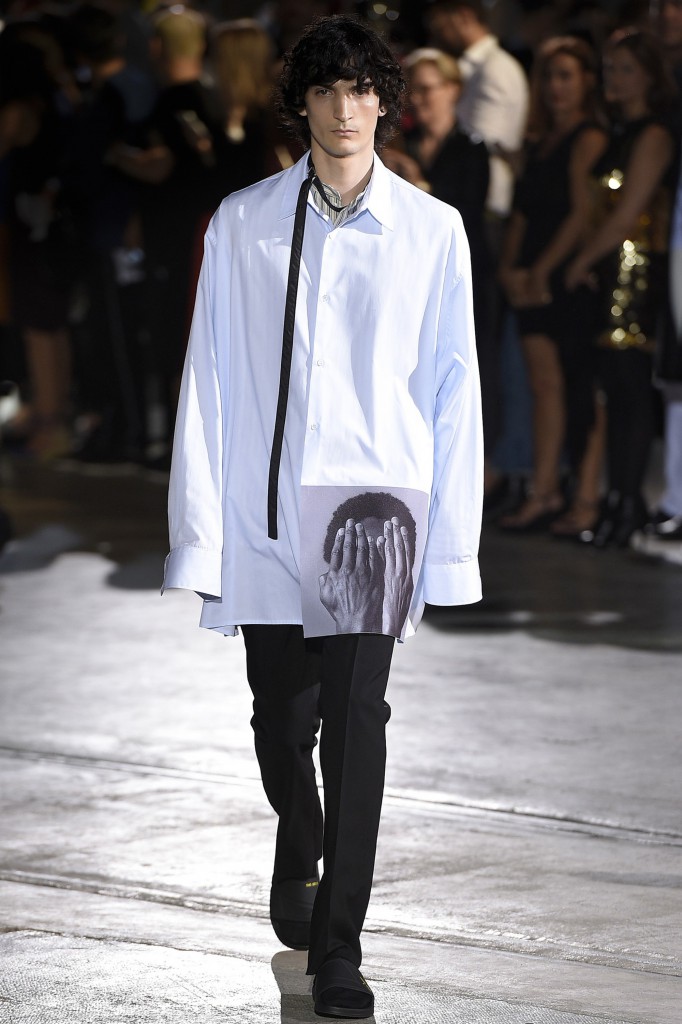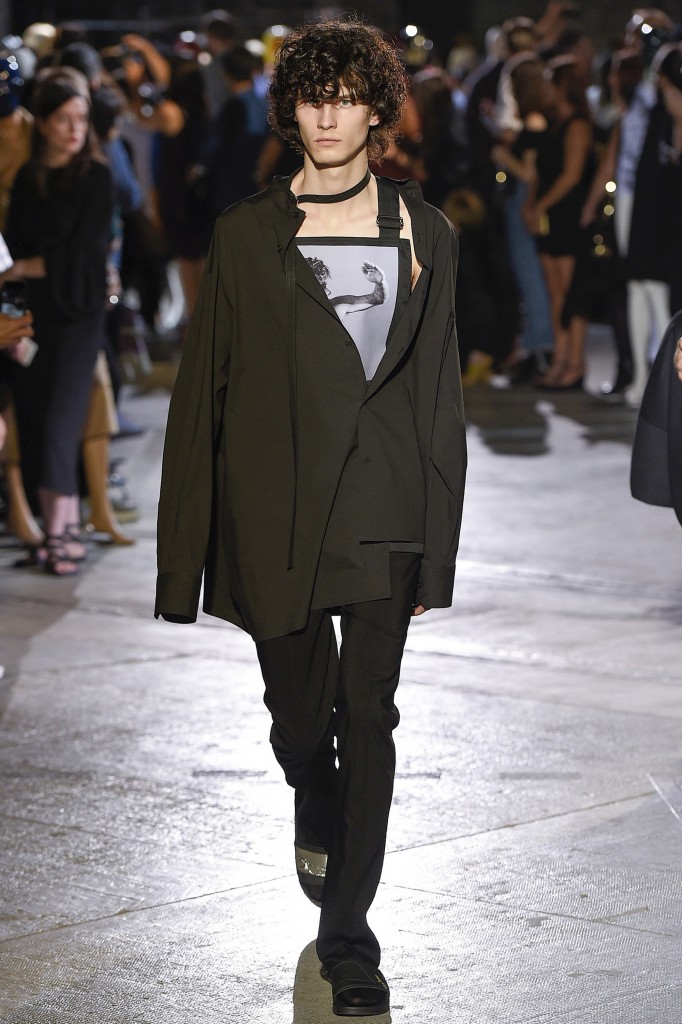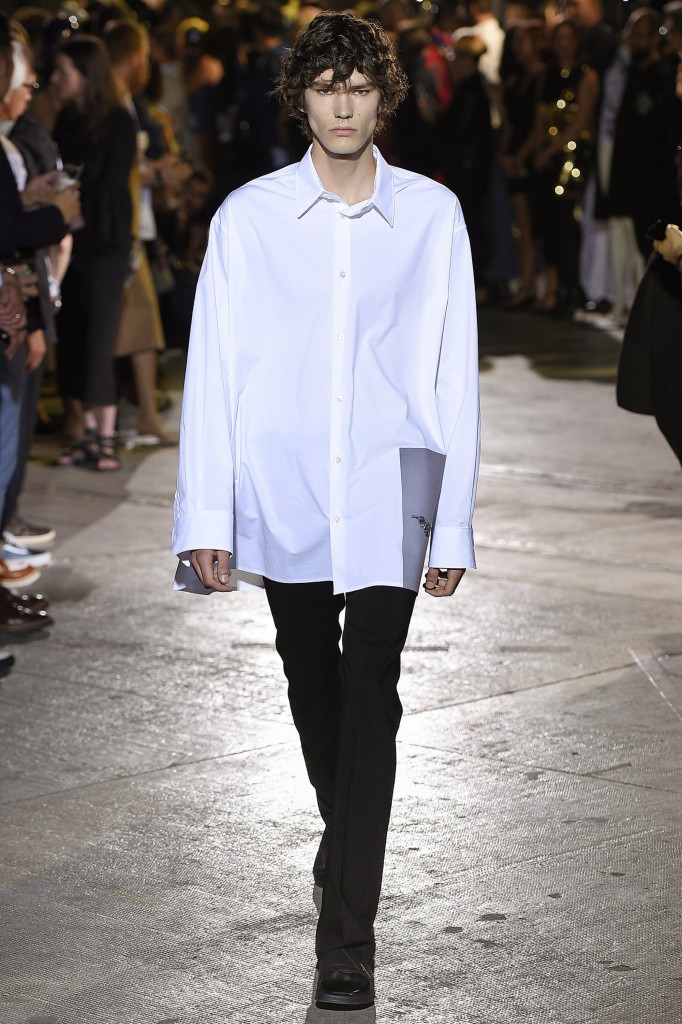Raf Simons Menswear Spring 2017, Florence
Earlier this year, the Robert Mapplethorpe Foundation contacted Raf Simons. They asked if he’d like to work with them on something. He said yes. That’s the shorthand version of the story behind the collection he presented at Pitti Immagine Uomo, perfectly chimed with a duo of Mapplethorpe exhibitions at LACMA and the Getty Museum, and the HBO documentary subtitled Look at the Pictures. It was the right time. And Simons is a Mapplethorpe fan, so it was the right artist. “I was honored,” Simons said after his show, his voice vibrating with emotion. Hence he shelved the idea he was working on for a collection (he wouldn’t reveal what it was; it may, he said, come out in a later show) and began his latest artist collaboration.
Normally, when Simons works with an artist, he approaches them. This time, the dynamic had somewhat shifted. The generosity of the Mapplethorpe Foundation’s offer is reflected in the generosity of Simons’s interpretation: There’s no outfit in Simons’s Spring 2017 show that doesn’t feature a photographic print of a Mapplethorpe. His curly-haired male models, with seductively slanted leather biker caps, often bore a striking resemblance to the photographer himself—though Simons stated that, rather than the artist’s doppelgängers, “every boy is a representation of a piece of work.” Each could be a Mapplethorpe sitter. The billowing shirts had shades of Mapplethorpe’s famous muse Patti Smith on her Horses album cover. Robert Sherman, a model whose alopecia made his skin approximate marble in his many portraits shot by Mapplethorpe, also attended the show. Simons had to clear third-party rights with all the sitters before reproducing their images. It began a dialogue that resulted in an immersion on Simons’s part in Mapplethorpe’s work.
That being said, the artist sat for himself a lot. Mapplethorpe was a fascinating character, and the art is inextricable from the man. “If you think about the work, it is so much about him,” said Simons, and, indeed, it was so much about the clothes he wore, too. On a voyage of sexual self-discovery, many of Mapplethorpe’s first pictures were Polaroid self-portraits, trussed up in leather gear, testing the limits of pleasure and pain. Later, he documented his own sexual fetishes; the leather scene and BDSM predominantly. Clothing was a vital component: At one point, Mapplethorpe began stretching his own (worn) underwear across wooden frames to form unconventional sculptures; later, he clad himself in black leather.
Simons knows all of that. Hence the fact his homage to Mapplethorpe felt so thoroughly rounded, so passionate and truthful. The subtlety of Simons’s multiple references gave the show depth—his palette of black; white; the bruised-flesh shades of crimson, pink, and purple; and the burgundy of coagulated blood; the leather dungarees glinting with metallic buckles. Simons spent two afternoons pawing through the Mapplethorpe archives of contact sheets. He struggled with the English terminology to describe those: He called them “maps,” which is a far more interesting and evocative notion when applied to Simons’s search, to find new territory for Mapplethorpe, to make him feel relevant and exciting to a new generation. That’s what he saw his role as.
I’m a Mapplethorpe fan too. I couldn’t help but ally this show to Mapplethorpe’s fascination with frames, with giving his imagery a three-dimensional element, a sculptural quality by framing and matting in plush velvets and exotic woods, attaching imagery to objects. Making his photographs more than they may first appear. Simons framed Mapplethorpe’s images with cloth, but then further framed them on the body: an image printed on a tabard, say, surmounted by the curtains of jacket lapels, or revealed on a T-shirt under a loosely draped sweater. Simons gravitated towards Mapplethorpe’s sexualized images of flowers, his idealized portraits of famous subjects like Debbie Harry, caught in coronas of light, and of artists whom Simons also shares an admiration for, like Alice Neel, captured a week or so before her death in an extraordinary 1984 portrait. Sex was in there, too; Simons was insistent on that. A down-stuffed jacket memorably turned to reveal an image of an erect phallus.
He also used the phrase “curation” to describe this show: “I wanted to approach it like a museum show, or a gallery show. Which has been done very often when it comes to Mapplethorpe’s work. Cindy Sherman did it, David Hockney did it. But always in a gallery.” Simons frowned. “I am a fashion designer. I thought the biggest challenge would be to do it in my own environment.”
The curatorial aspect made for a fascinating notion, especially in a time when so many designers appropriate and reference without credit—and when so many people throw around the verb “curate.” It’s indicative of Simons’s nature—respectful, quiet, intellectually hefty—that he saw this collection not as his creations with Mapplethorpe’s imagery tacked on, but as a collaboration akin to a gallery show, where his role was, at least in part, to best showcase the works he was given. But it was also to use those works to tell a new, exciting, and provocative story. To show us something new from the well known, and much seen, archives of Mapplethorpe. Which he undoubtedly did.
Source: Vogue.com.
Text: Alexander Fury, Vogue.com.
All images belongs to the respective artist and management.


